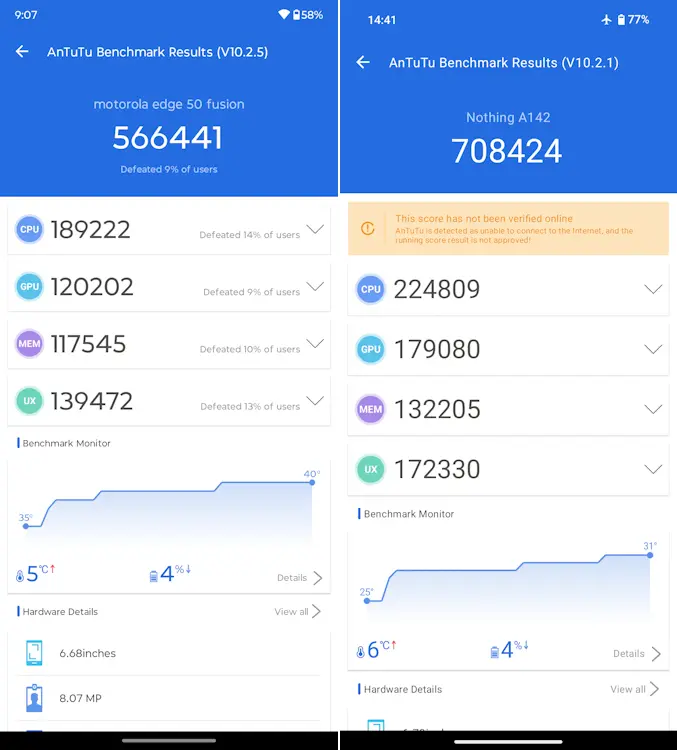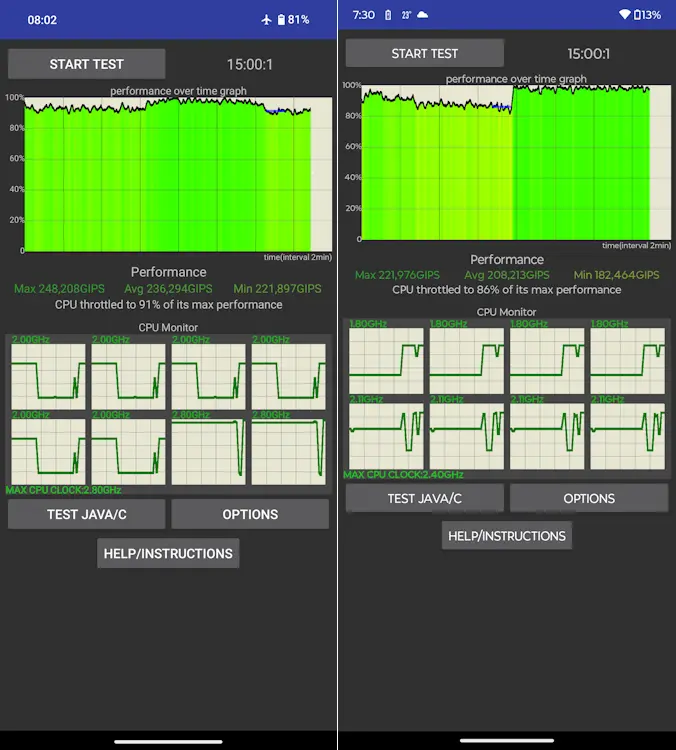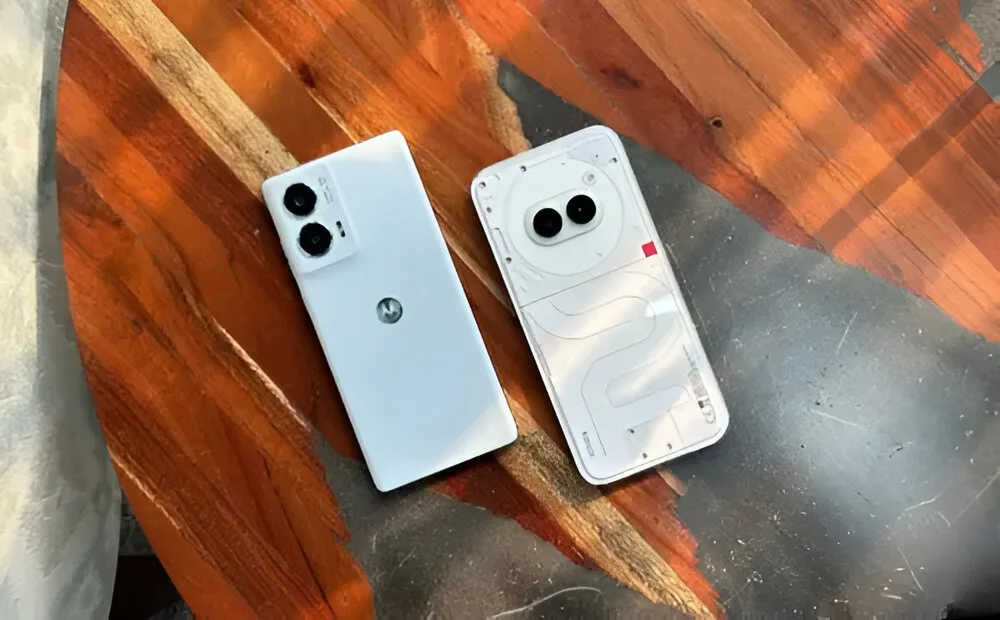
India’s affordable mid-range smartphone market has welcomed the Moto Edge 50 Fusion. Starting at Rs 22,999, it is Rs 3,000 cheaper than the Nothing Phone 2a, which launched two months ago. If your budget is around Rs 25,000, which device should you choose? That’s what we aim to discover as we compare the two devices in this detailed comparison. Let’s dive right in and compare the Moto Edge 50 Fusion with the Nothing Phone 2a.
Moto Edge 50 Fusion vs Phone 2a: Specs

Box Contents
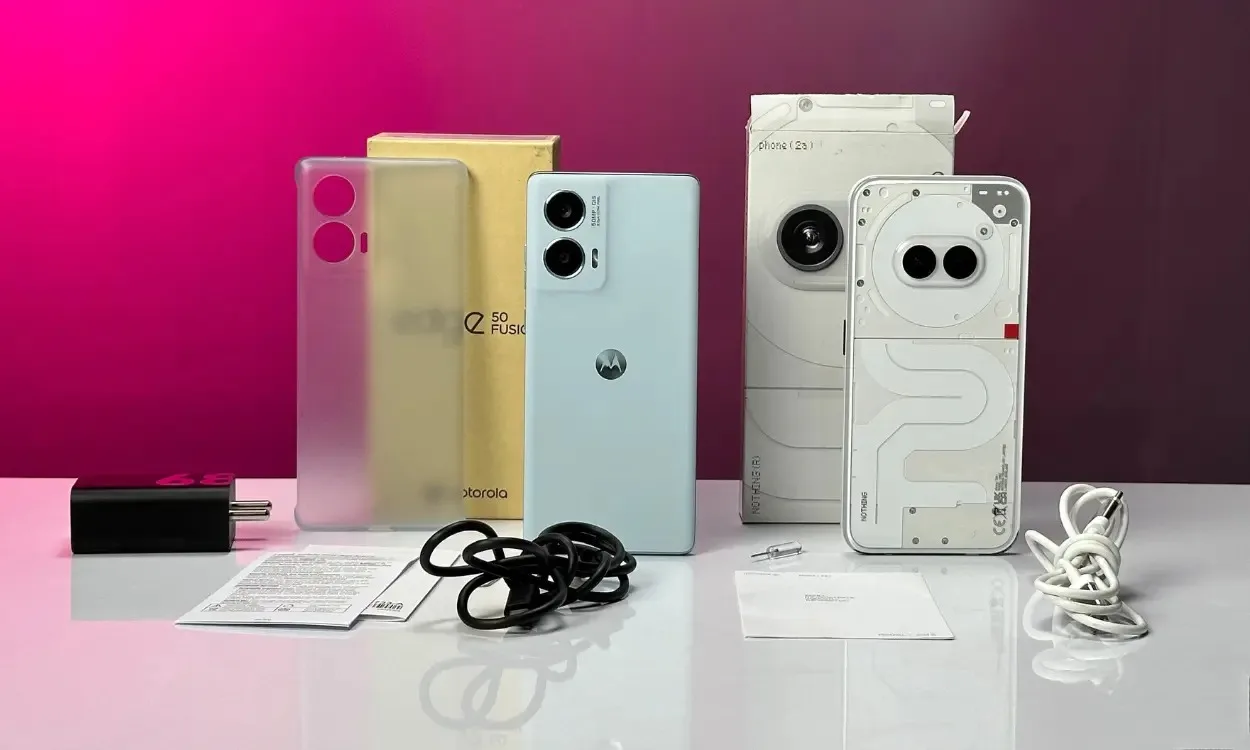
If you have read our review of the Nothing Phone 2a, you know that its box contents are minimal. Apart from the handset itself and a Type-C cable, there’s nothing else inside. On the other hand, the Edge 50 Fusion’s box includes a 68W fast charger, a cable, and a high-quality transparent case. In this regard, the Edge 50 Fusion clearly has an advantage.
Moto Edge 50 Fusion vs Phone 2a: Design
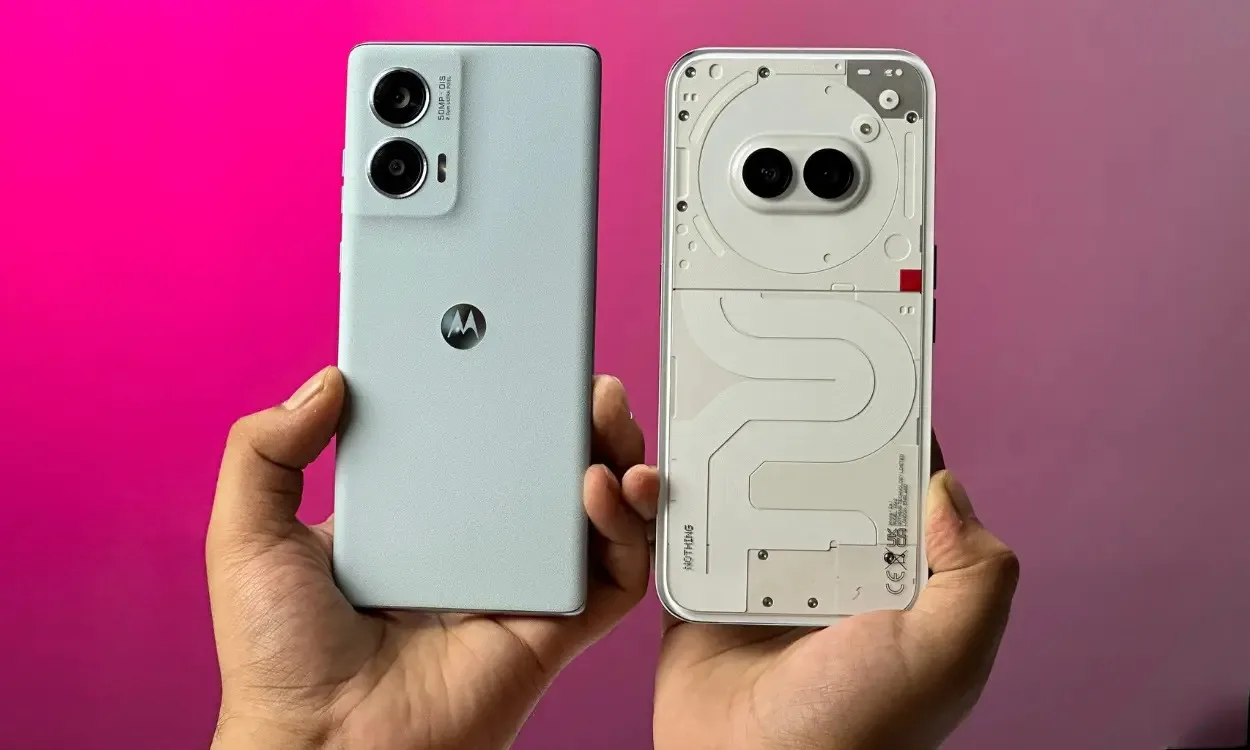
Regarding the phones, I have the White variant of the Phone 2a and the Marshmallow Blue variant of the Edge 50 Fusion here at the Beebom office.
Diving into the specifics, these devices boast distinct designs. The Phone 2a showcases a Nothing-trademark transparent design and Glyph Interface on a plastic back, while the Edge 50 Fusion’s Marshmallow Blue variant features a vegan leather back, a material Motorola has been using recently. However, the Forest Blue variant of the Edge 50 Fusion comes with a plastic back.
Although the Phone 2a’s back panel is prone to scratches, the Edge 50 Fusion’s leather back can get smudged easily. This is particularly noticeable on the Marshmallow Blue variant I’m using.
When I picked up the devices, I immediately noticed how much boxier the Phone 2a felt in hand compared to the sleeker and more ergonomic Edge 50 Fusion. Notably, the Edge 50 Fusion boasts an IP68 dust and water resistance rating, which is rare in this segment, while the Phone 2a has an IP54 rating.
Both phones have a plastic frame, but the Phone 2a features aluminum volume rockers and a power button, which feel more tactile and stable compared to the plastic buttons on the Edge 50 Fusion. Additionally, the button placement on the Phone 2a is more convenient, with the buttons distributed on either side of the frame.
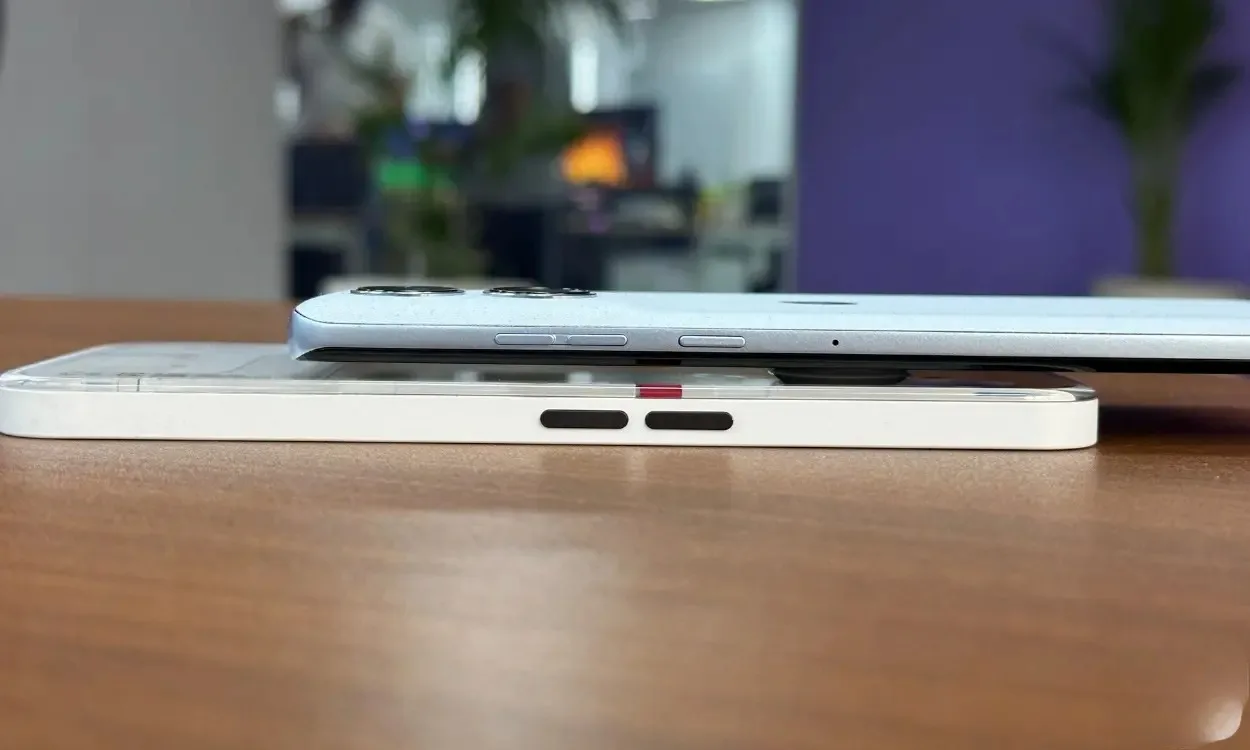
The Phone 2a’s plastic body feels cheaper in hand compared to the premium feel of the Edge 50 Fusion’s leather back. However, the Phone 2a is lighter, and its well-placed camera module prevents wobbling when placed on a desk.
It’s worth noting that the Phone 2a has slightly curved edges, making it comfortable to hold without digging into your skin. The Edge 50 Fusion, on the other hand, has slightly sharper edges.
Moto Edge 50 Fusion vs Phone 2a: Display

Both phones have 6.7-inch displays protected by Gorilla Glass 5. The Edge 50 Fusion’s display is curved and comes without any additional layers on top.
Keep in mind that UV protectors may not be ideal for your display. The Phone 2a, with its protective sheet and flat display, is compatible with readily available tempered glass protectors.
I’ve always praised the Phone 2a’s bright display, which recorded 1750 nits of brightness using our Lux Meter at the Beebom office. This level of brightness provides excellent visibility indoors and outdoors, surpassing other phones in its segment like the POCO X6 Pro, POCO X6, or Moto Edge 40 Neo.
While the Edge 50 Fusion’s peak brightness of 1600 nits is impressive, it does feel slightly dimmer compared to the 2a’s panel. When watching “The Batman” and the Costa Rica 4K video on YouTube, I observed that the whites appeared brighter and the blacks looked darker on the Phone 2a’s display.
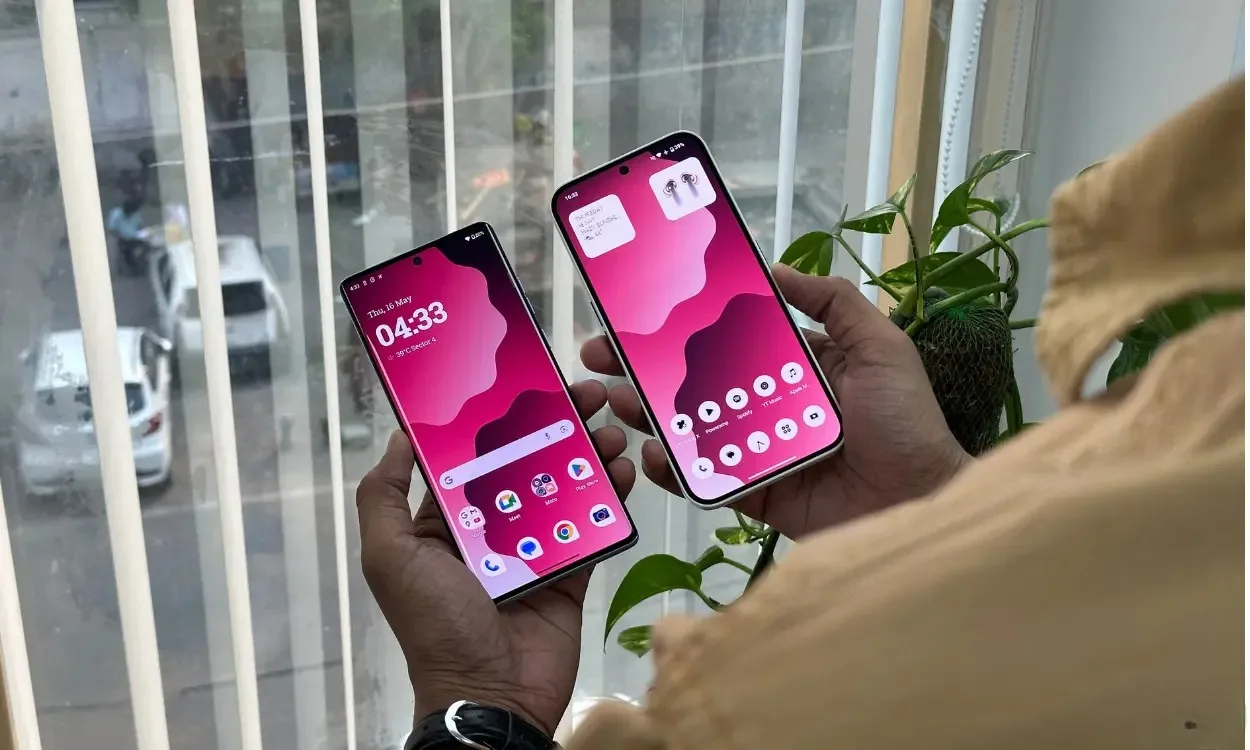
Both phones offer similar richness of color, thanks to their DCI-P3 coverage. However, the Edge 50 Fusion’s faster 144Hz refresh rate provides noticeably smoother visuals compared to the Phone 2a’s 120Hz cap.
One notable difference is that the Edge 50 Fusion currently does not support playing 4K YouTube or Netflix videos in HDR, although this may be addressed in a future software update from Moto. In contrast, the Phone 2a already supports this feature. Additionally, both phones boast a robust stereo speaker setup to complement their displays.
Moto Edge 50 Fusion vs Phone 2a: Software Experience
Now, let’s delve into the software side of things on the two phones, which is probably what you’re most interested in. Both phones come with Android 14 out of the box and are promised to receive 3 years of major OS updates and 4 years of security patches.

In terms of the user interface, the Phone 2a runs on Nothing OS 2.5, while Motorola has recently transitioned from its MyUX skin to Hello UI. We first saw Hello UI on the Edge 50 Pro, and encountering it on the Edge 50 Fusion was a bit surprising.
One notable downside is the presence of bloatware. The Phone 2a comes with preinstalled LinkedIn and Facebook apps, the weather app includes ads, and there’s a home screen widget that displays ads as well. While you can remove these, they still qualify as bloatware in my opinion.
On the contrary, the Phone 2a offers a much cleaner software experience. Besides essential Google apps, it doesn’t push you to use any additional apps. However, the software preference is highly subjective.
If you prefer a less feature-heavy experience, a truly bloatware-free setup, and a more streamlined user interface, Nothing OS is the way to go. Additionally, Nothing OS now offers some interesting widgets, along with the highly discussed ChatGPT integration.
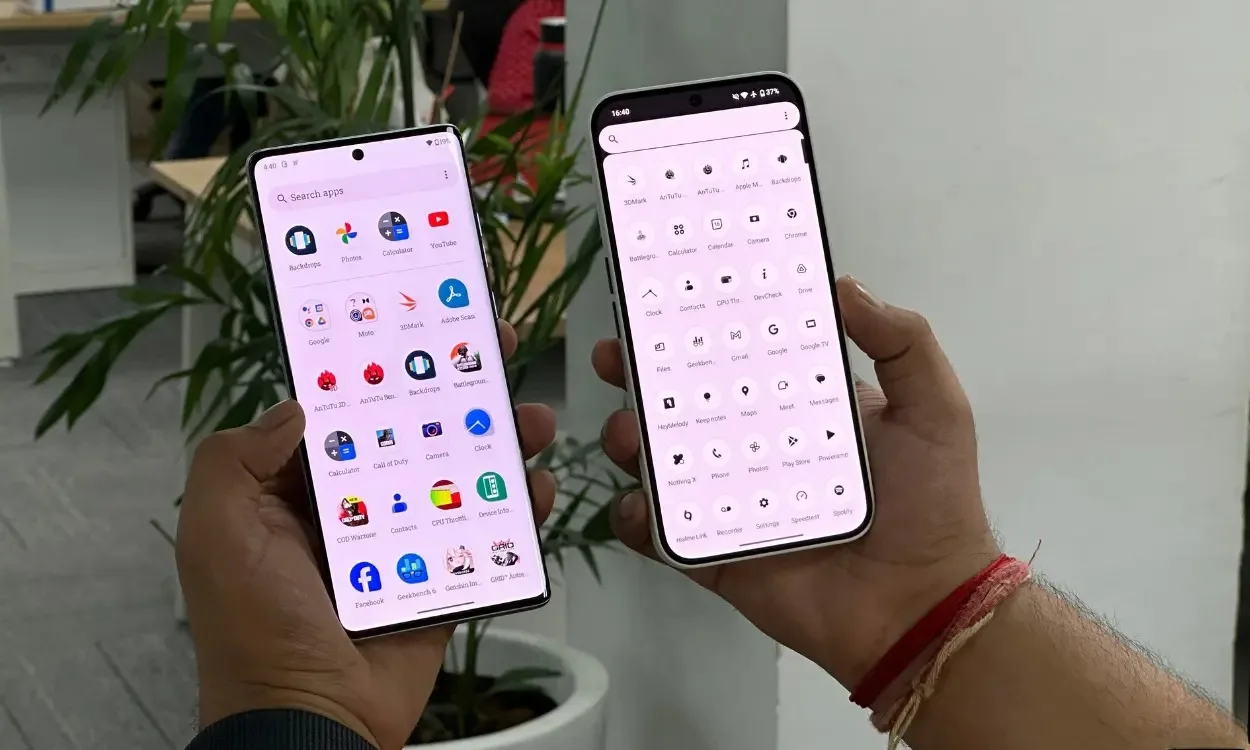
Moreover, the Glyph Interface offers features like Essential Notifications and a Progress Bar that can be quite useful. Additionally, if you own a Nothing Phone, you can benefit from the ChatGPT integration that comes with all of the brand’s earbuds.
If you’re seeking a more feature-rich experience, Hello UI should meet your needs. It comes with several proprietary features like Moto Connect, Family Space, Moto Unplugged, and Moto Secure.
Furthermore, Moto Ready For is a standout feature, surpassing the functionality of the Windows Phone Link app. With Moto Ready For, you can mirror your phone to your PC, drag and drop files, stream apps, share the clipboard, and more. I appreciate that Moto hasn’t restricted these features just because it’s a budget phone. Xiaomi, take note.
Despite its strengths, the Edge 50 Fusion suffers from UI optimization issues, similar to what the Phone 2a experienced initially. While Nothing has addressed most of these issues with multiple software updates, I’m unsure about Moto’s track record in this regard.
I encountered a few issues with the Edge 50 Fusion:
1. Stuttering when opening or closing the camera app
2. Slight sluggishness in display refresh rate when set to Auto
3. Minor stutters while navigating the UI
4. Excessively harsh and unnecessary haptic feedback, especially when browsing through recent apps
Despite these issues, the Hello UI is quite decent. However, it needs some refinement and filtering to match the cleaner UI of the Nothing Phone.
Moto Edge 50 Fusion vs Phone 2a: Performance

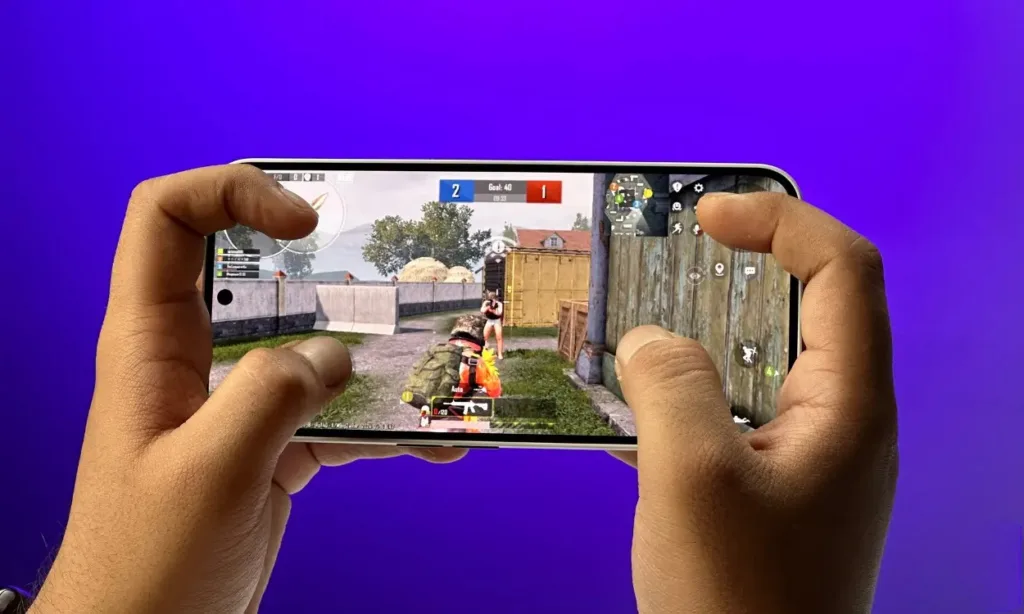
Both phones excel in the performance department. The Phone 2a is equipped with the MediaTek Dimensity 7200 Pro 4nm chipset, while the Edge 50 Fusion runs on the Snapdragon 7s Gen 2. Both processors are supported by up to 12GB of LPDDR4X RAM and 256GB of UFS 2.2 internal storage. Here are my detailed findings after comparing the two devices:
Benchmarks
The Dimensity 7200 Pro in the Phone 2a outperforms the 7s Gen 2 in the Edge 50 Fusion in every benchmark I conducted, including AnTuTu, where there’s nearly a 200k difference in scores.
Moreover, I observed that the 7200 Pro on the Phone 2a was more stable, throttling at 91% compared to the 7s Gen 2’s 86%. Here’s a summary of the tests I conducted:
Day-to-day Performance
Despite the Hello UI’s UI optimization issues, which were noticeable during active use, it didn’t become too problematic. However, the Phone 2a offered a superior level of seamlessness. On an average day, I have around 10 to 15 apps open in the background, and while both phones handled this well, the Phone 2a performed slightly better.
The Phone 2a exhibited smoother performance in tasks like opening and closing apps and multitasking. Both phones demonstrate strong thermal management capabilities, even in the peak summers of a hot place like Noida. However, I did notice that the Phone 2a dims its display faster in direct sunlight to prevent overheating.
Gaming
Moving on to gaming, both phones performed admirably. While they aren’t gaming phones per se, they handle gaming well and can easily accommodate games like Genshin Impact, CoD Mobile, and BGMI. Here’s an overview of their gaming performance:

Additionally, both devices maintained consistent performance without throttling during gaming sessions. The temperatures also remained relatively normal, peaking at a maximum of 38 degrees.
Moto Edge 50 Fusion vs Phone 2a: Cameras

When it comes to cameras, the Moto Edge 50 Fusion features a 50MP Sony LYT 700C primary sensor, paired with a 13MP ultra-wide-angle sensor, and a 32MP selfie camera.
In contrast, the Nothing Phone 2a is equipped with a 50MP Samsung ISOCELL GN9 primary sensor and a 50MP Samsung ISOCELL JN1 sensor alongside it. For selfies, it offers a 32MP Sony IMX 615 sensor.
How do these camera setups perform in real-world scenarios? Let’s find out:
Primary Sensor
The Sony LYT 700C primary sensor on the Edge 50 Fusion is truly impressive. While I’ve always admired the camera quality of the Phone 2a, the Edge 50 Fusion surpasses it. The Phone 2a tends to capture more natural skin tones and colors, but there are some inconsistencies.
In one instance, when I attempted to capture a human subject on a very sunny day, the Phone 2a completely overexposed the background. In contrast, the Moto Edge 50 Fusion handled the situation much better. While it does enhance colors, the result is noticeably superior. The Phone 2a also tends to darken shots at times.


Moreover, details are better preserved in Edge 50 Fusion shots, especially when zooming in on hair and skin details. However, there’s a noticeable amount of sharpening in the Edge 50 Fusion’s shots, which may not appeal to everyone.
On the other hand, the Phone 2a exhibits better dynamic range, effectively managing shadows and highlights. While the Edge 50 Fusion is not lacking in this aspect, it doesn’t quite match up. This holds true even in low-light conditions, where the Phone 2a tends to capture slightly brighter photos, while the Edge 50 Fusion excels in color accuracy and brightness levels.
Ultra-Wide-Angle Sensor
The Edge 50 Fusion retains slightly better details in shots compared to the Phone 2a, especially noticeable when zooming in on hair and skin. However, there’s a noticeable amount of sharpening in the Edge 50 Fusion’s shots, which may not appeal to everyone.
On the other hand, the Phone 2a exhibits better dynamic range, handling shadows and highlights more effectively. While the Edge 50 Fusion is decent in this regard, it doesn’t quite match up. This holds true even in low-light conditions, where the Phone 2a tends to capture slightly brighter photos, while the Edge 50 Fusion excels in color accuracy and brightness levels.


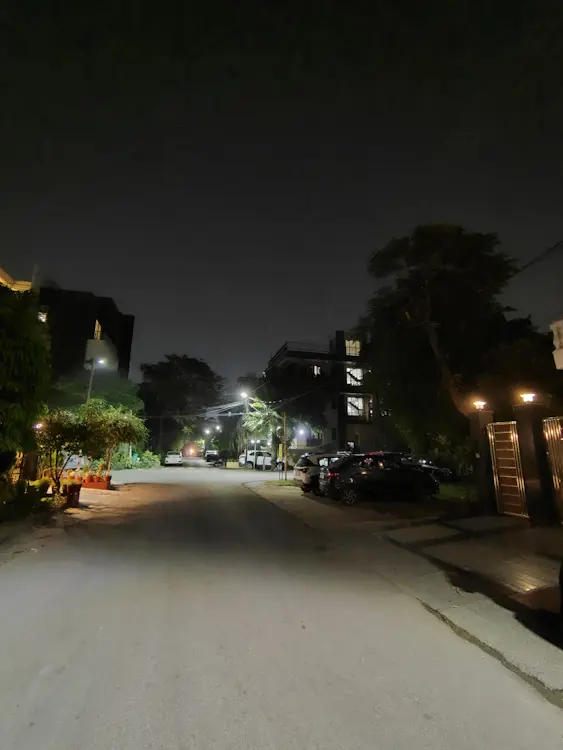

When it comes to the ultra-wide-angle sensor, however, the Phone 2a takes the lead. Its 50MP sensor captures details exceptionally well, surpassing the capabilities of the Edge 50 Fusion’s 13MP sensor, which has limitations in capturing fine details.
However, there is still some color disparity noticeable on the Phone 2a’s sensors when switching between the primary and ultra-wide-angle sensors, a problem absent on the Edge 50 Fusion.
Similarly, even with ultra-wide shots, the Edge 50 Fusion enhances colors, while the Phone 2a maintains natural colors well. In low-light conditions, the Edge 50 Fusion struggles, resulting in smudged details and significant noise in shots. In contrast, the Phone 2a’s wide-angle sensor consistently captures detailed shots.
Selfies
For selfies, the Phone 2a offers better detail, but the Edge 50 Fusion excels in capturing natural-looking skin tones, whereas the Phone 2a tends to boost them. Both phones perform well in edge detection and depth mapping, although the Edge 50 Fusion applies noticeable skin softening effects, which can appear unnatural at times.
Videos
In terms of video recording, both phones support recording at up to 4K 30FPS and 1080p 60FPS using the primary sensor. However, the Phone 2a is limited to 1080p 60FPS for front-facing videos, while the Edge 50 Fusion can capture up to 4K 30FPS.
Moto Edge 50 Fusion vs Phone 2a: Battery Life
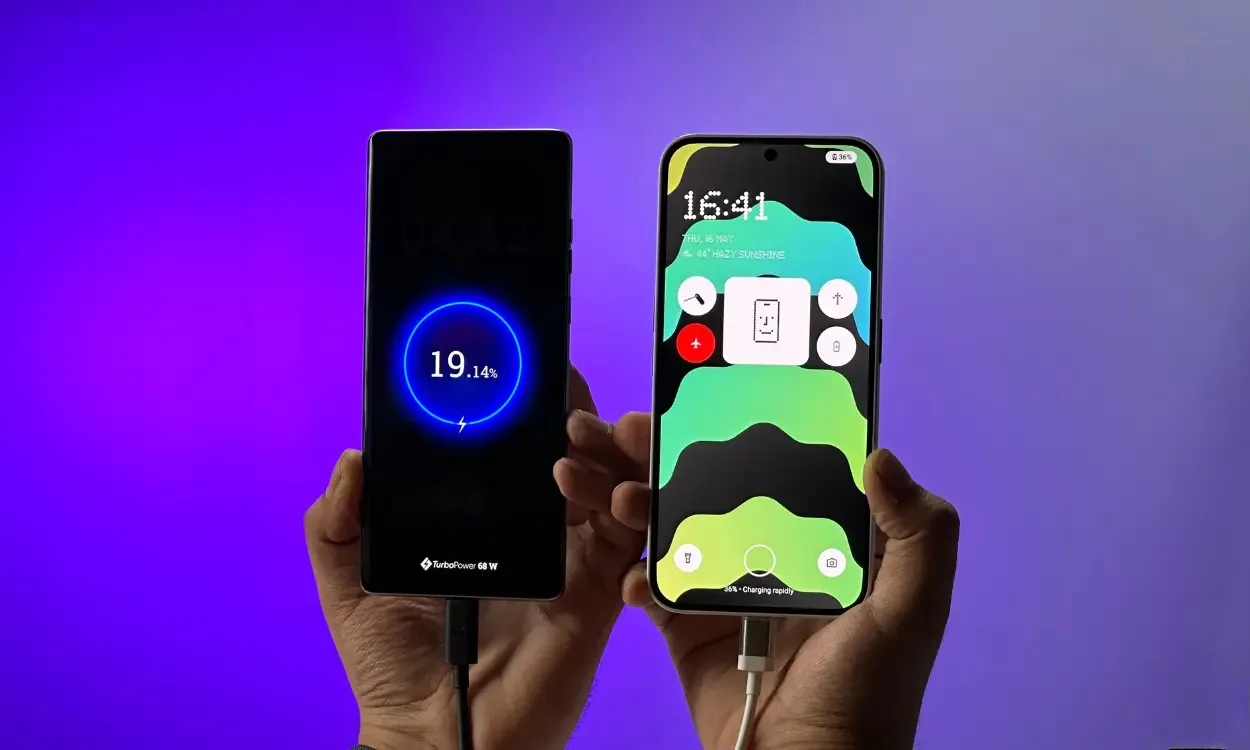
In the battery department, both phones feature a sizable 5000mAh battery. However, the Edge 50 Fusion boasts faster 68W fast charging, while the Phone 2a’s charging speed is capped at 45W.
In terms of screen-on-time, the Edge 50 Fusion offers longer usage. After an hour of camera use, around 3 hours of YouTube and Netflix viewing, and an hour of gaming with Genshin Impact, I still had 30% battery remaining. With moderate usage, you can easily achieve around 8.5 hours of screen-on-time. In comparison, the Phone 2a provides approximately 7 hours of screen-on-time.
Due to the Edge 50 Fusion’s less power-hungry processor, it doesn’t require as much battery capacity in the first place.
When it comes to charging, the Edge 50 Fusion takes a slight lead, fully charging in about an hour from 0%. The Phone 2a, on the other hand, takes around 1 hour and 10 minutes to reach full charge.
Moto Edge 50 Fusion vs Phone 2a: Who Wins?
The conclusion of this comparison is straightforward. If you prioritize a superior display, a cleaner software experience, a distinctive design, and higher performance, the Nothing Phone 2a is the way to go. However, if you value a solid feel in hand, longer screen-on-time, and a commendable primary camera sensor, the Edge 50 Fusion is the better choice.
Additionally, the debate between curved and flat displays is worth noting. While the Edge 50 Fusion’s plastic OLED display is less prone to breaking, the Gorilla Glass 5 protection offers added durability.
The deciding factor, however, lies in the box contents. The Edge 50 Fusion includes everything you need, including a high-quality case and a fast charger. Considering these factors and the Rs 3,000 price difference, the Edge 50 Fusion is a clear winner over the Phone 2a.
